Alternative names Hommus | Course Meze | |
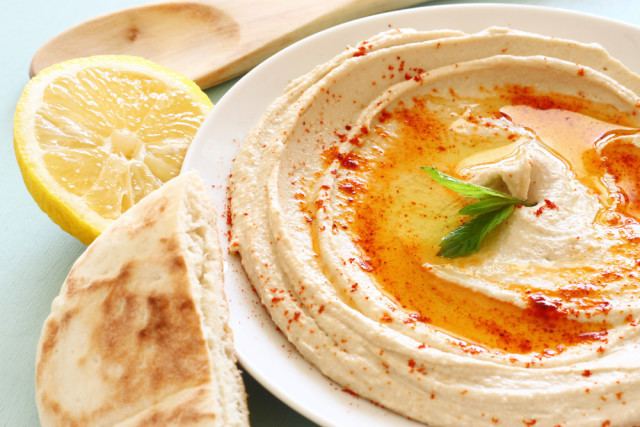 | ||
Serving temperature Room temperature or warm Similar Tahini, Chickpea, Falafel, Pita, Baba ghanoush | ||
How to make hummus that s better than store bought easy hummus recipe
Hummus (/ˈhʊ.məs/, /ˈxʊ.mʊs/, or /ˈhʌ.məs/; Arabic: حُمُّص Hebrew: חומוס, full Arabic name: hummus bi tahini) is a Levantine and Egyptian food dip or spread made from cooked, mashed chickpeas or other beans, blended with tahini, olive oil, lemon juice, salt and garlic. Today, it is popular throughout the Middle East (including Turkey), North Africa (including Morocco), and in Middle Eastern cuisine around the globe. It can be found in most grocery stores in North America.
Contents
- How to make hummus that s better than store bought easy hummus recipe
- Classic hummus recipe everyday food with sarah carey
- Etymology and spelling
- History
- Regional preparations
- Nutrition
- United States
- Controversy
- World record
- References
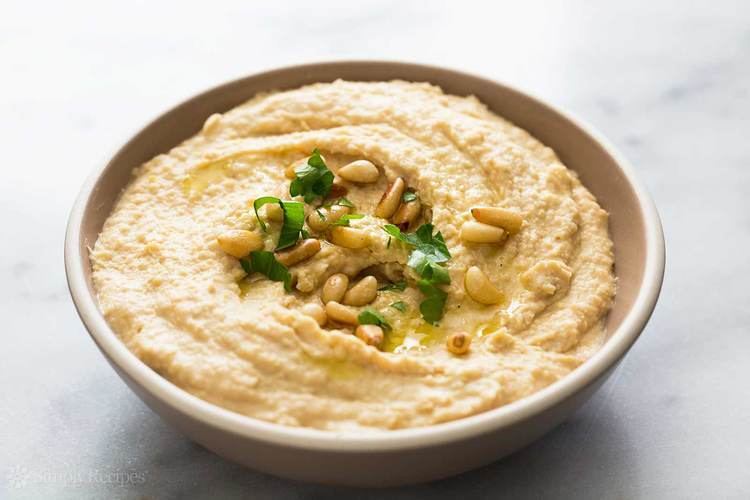
Classic hummus recipe everyday food with sarah carey
Etymology and spelling
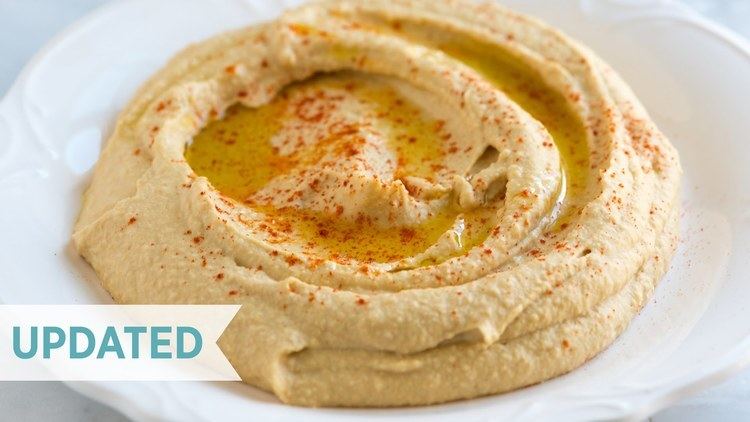
"Hummus" comes from the Arabic word meaning "chickpeas", and the complete name of the prepared spread in Arabic is ḥummuṣ bi ṭaḥīna which means "chickpeas with tahini".
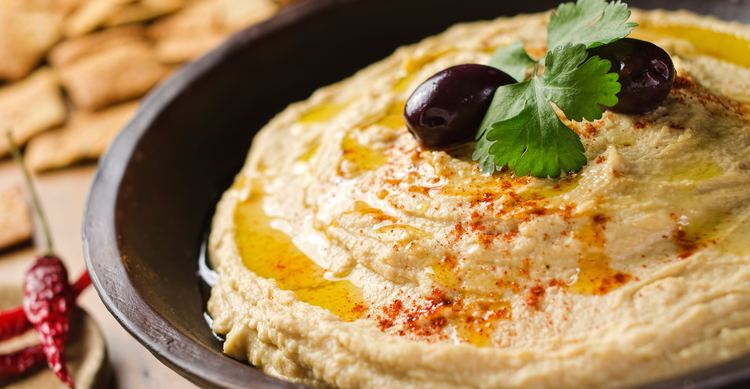
Spelling of the word in English can be inconsistent. "Hummus" is the most common spelling in both American and British English. The spelling "houmous" is however common enough in British English to be also listed as a less common spelling in some UK dictionaries but not, for example, in the Cambridge online dictionary. Some US dictionaries also list other spellings such as humus, hommus, and hommos, but not Merriam-Webster, for example.
History
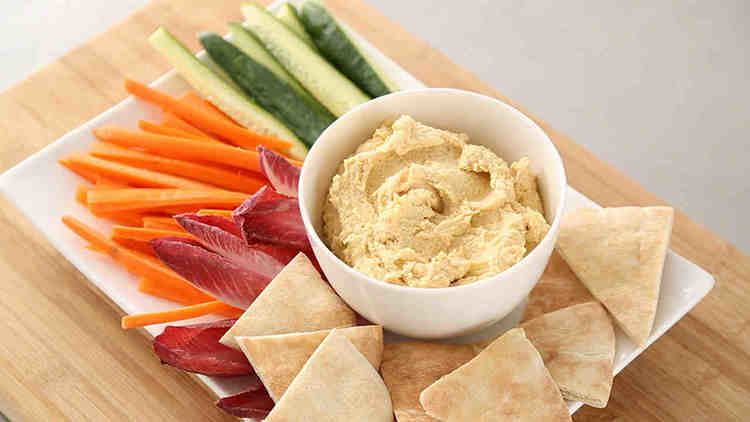
The earliest known recipes for a dish similar to hummus bi tahina are recorded in cookbooks written in Cairo in the 13th century. Hummus has been connected to the Ayyubid Sultan, Saladin, and according to some food historians he first prepared it. A cold purée of chickpeas with vinegar and pickled lemons with herbs, spices, and oil, but no tahini or garlic, appears in the Kanz al-Fawa'id fi Tanwi' al-Mawa'id; and a purée of chickpeas and tahini called hummus kasa appears in the Kitab Wasf al-Atima al-Mutada: it is based on puréed chickpeas and tahini, and acidulated with vinegar (though not lemon), but it also contains many spices, herbs, and nuts, and no garlic. It is also served by rolling it out and letting it sit overnight, which presumably gives it a very different texture from hummus bi tahina. Indeed, its basic ingredients—chickpeas, sesame, lemon, and garlic—have been eaten in the region for millennia. Though chickpeas were widely eaten in the region, and they were often cooked in stews and other hot dishes, puréed chickpeas eaten cold with tahini do not appear before the Abbasid period in Egypt and the Levant.
Regional preparations
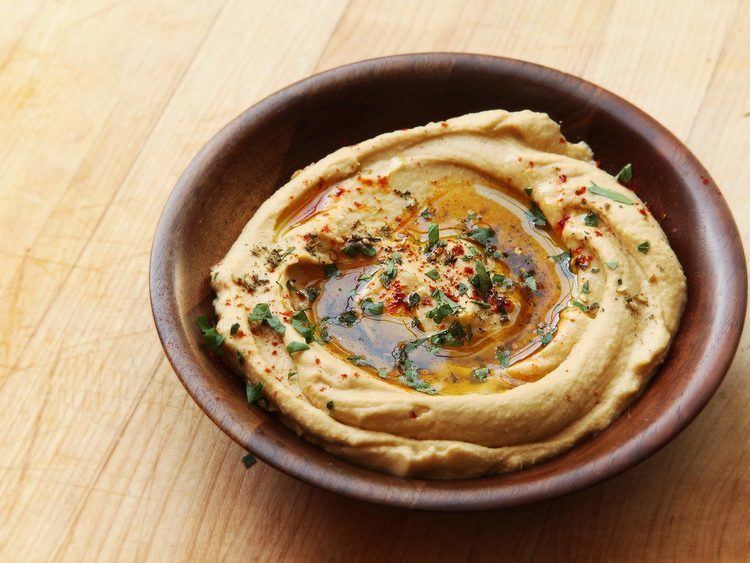
As an appetizer and dip, hummus is scooped with flatbread, such as pita. It is also served as part of a meze or as an accompaniment to falafel, grilled chicken, fish or eggplant. Garnishes include chopped tomato, cucumber, coriander, parsley, caramelized onions, sautéed mushrooms, whole chickpeas, olive oil, hard-boiled eggs, paprika, sumac, ful, olives, pickles and pine nuts. Outside the Middle East, it is sometimes served with tortilla chips or crackers.
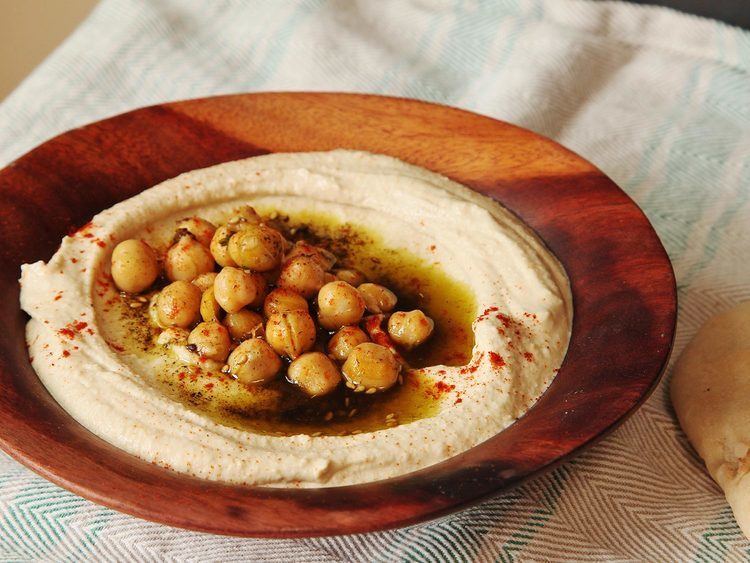
Hummus ful (pronounced [fuːl]) is topped with a paste made from fava beans boiled until soft and then crushed. Hummus masubha/mashawsha is a mixture of hummus paste, warm chickpeas and tahini.
Hummus is a popular dip in Israel and Egypt where it is eaten with pita bread, and frequently flavored with cumin or other spices.
Hummus is a common part of everyday meals in Israel. A significant reason for the popularity of hummus in Israel is that it is made from ingredients that, following Kashrut (Jewish dietary laws), can be combined with both meat and dairy meals. It is seen as almost equally popular among Israeli Jews and Israeli Arabs. Though not a traditional Jewish food, it is sufficiently popular in Israel to be found in numerous hummus-only restaurants across the country and is regarded as a national food.
Many restaurants run by Mizrahi Jews and Arab citizens of Israel are dedicated to warm hummus, which may be served as chick peas softened with baking soda along with garlic, olive oil, cumin and tahini. One of the fancier hummus versions available is hummus masabacha, made with lemon-spiked tahini garnished with whole chick peas, a sprinkling of paprika and a drizzle of olive oil.
For Palestinians and Jordanians, hummus has long been a staple food, often served warm, with bread for breakfast, lunch or dinner. All of the ingredients in hummus are easily found in Palestinian gardens, farms and markets, thus adding to the availability and popularity of the dish. In Palestine, hummus is usually garnished, with olive oil, "nana" mint leaves, paprika, and parsley. A related dish popular in Palestine and Jordan is laban ma' hummus ("yogurt and chickpeas"), which uses yogurt in the place of tahini and butter in the place of olive oil and is topped with pieces of toasted bread.
One author calls hummus, "One of the most popular and best-known of all Syrian dishes" and a "must on any mezzeh table." Syrians in Canada's Arab diaspora prepare and consume hummus along with other dishes like falafel, kibbe and tabouleh, even among the third- and fourth-generation offspring of the original immigrants.
In Cyprus, hummus is part of the local cuisine in both Turkish Cypriot and Greek Cypriot communities where it is called "humoi" (Greek: χούμοι). In Turkey, hummus is considered as a meze and usually oven-dried with pastırma which differs from the traditional serving.
Nutrition
Chickpeas, the main ingredient of conventional hummus, have appreciable contents of dietary fiber, protein, B vitamins, manganese and other nutrients.
As hummus recipes vary, so does nutritional content, depending primarily on the relative proportions of chickpeas, tahini, and water. Hummus provides roughly 170 calories for 100 grams, and is a good to excellent (more than 10% of the Daily Value) source of dietary fiber, B vitamins, and several dietary minerals.
Fat content, mostly from tahini and olive oil, is about 14% of the total; other major components are 65% water, 17% total carbohydrates, including a small amount of sugar, and about 10% protein.
United States
In 2006, hummus was present in 12 percent of American households, rising to 17 percent by early 2009. One commentator attributed the growth of hummus to America’s embrace of ethnic and exotic foods.
In 2008, more than 15 million Americans consumed hummus on a regular basis, becoming a popular staple in American restaurants with the Armenian migration from Lebanon to Southern California and the East Coast after the Lebanese Civil War (1975–1990). It was further popularized in the United States by Jews returning from visits in Israel and by Israeli expatriates.
Controversy
In October 2008, the Association of Lebanese Industrialists petitioned to the Lebanese Ministry of Economy and Trade to request protected status from the European Commission for hummus as a uniquely Lebanese food, similar to the Protected Geographical Status rights held over regional food items by various European Union countries.
Fadi Abboud, president of the Lebanese Industrialists Association, stated that "Israelis have usurped several Lebanese and oriental products", claiming that Lebanon exported the first hummus dish in 1959.
In response, food critic Janna Gur wrote: "The success of certain brands of Israeli hummus abroad may have been what brought about Abboud's anger", leading him to claim that Israel has been "stealing" their country's national dishes, like hummus, falafel, tabbouleh, and baba ghanouj. Shooky Galili, an Israeli journalist specialising in food and who writes a blog dedicated to hummus, said that "trying to make a copyright claim over hummus is like claiming for the rights to bread or wine. [...] Hummus is a centuries old Arab dish — nobody owns it, it belongs to the region".
As of late 2009, the Lebanese Industrialists Association was still "collecting documents and proof" to support its claim.
In 2012, Australian filmmaker Trevor Graham released a documentary, Make Hummus Not War, on the political and gastronomic aspects of hummus.
Subsequent attention has focused on the competition as to which country can hold the world record in preparing the largest batch of hummus (see next section).
World record
In May 2010, the Guinness World Record for the largest dish of hummus in the world returned to Lebanon. The winning dish, cooked by 300 cooks in the village of al-Fanar, near Beirut, weighed approximately 10450 kg (roughly 23000 lb), more than double the previous record set by 50 Israeli Arabs and Jews who cooked approximately 4100 kg (roughly 9000 lb) in January 2010 in the Arab-Israeli village of Abu Ghosh. According to local media, the recipe included eight tons of boiled chick peas, two tons of tahini, two tons of lemon juice and 70 kg (154 lb) of olive oil.
In 2015, Israeli filmmaker Oren Rosenfeld reported that Guinness World Record officials had refused to send a judge to Israel for his attempt to break the record, citing safety concerns, despite their having recently sent judges to other Middle Eastern countries. Fifteen tons of hummus would have been produced and shared as part of publicity for Rosenfeld's new film, Hummus the Movie.
